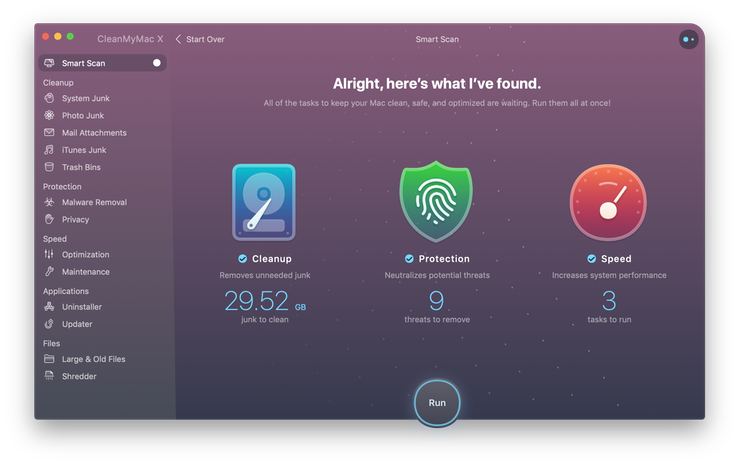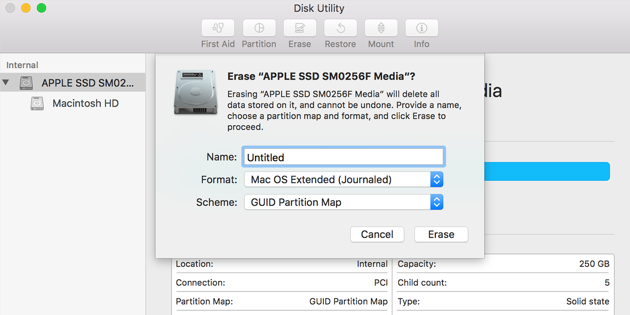Dual Boot Mac Os High Sierra
If y'all're excited almost the release of the macOS Mojave and are keen to install it and try information technology out, simply demand to be able to run Loftier Sierra too, y'all can create multiple volumes on your startup disk and boot from whichever one you choose.
And so, why dual booting is a good idea? For example, High Sierra was the final version of macOS that fully supported 32-flake applications. It'southward likely that in Mojave, if a 32-bit app runs at all, it volition have problems with performance and stability. Microsoft Office 2011 is 32-bit, every bit is Adobe CS half dozen. So, if you want to keep using those apps, you'll need to run them in High Sierra. That means y'all'll need to install macOS Mojave on a separate volume.
At that place are several different ways to dual kicking High Sierra and Mojave beta. You could run a virtual automobile, say Parallels Desktop or VMWare Fusion, and install Mojave on that. Or you could install Mojave on an external drive and kick from that when you want to use it. Yet, if yous want the best possible performance, it's amend to install the Bone natively on its own volume.
Step 1: Create space on your startup disk for another volume
Running two unlike versions of the operating organisation on the same drive takes up lots of space, particularly when you install applications and offset using them. To gratis upward space for the new volume, you should uninstall whatsoever apps y'all don't utilise and get rid of 'junk' files the OS has created but aren't needed. These include temporary files, caches, and files created past Photos and iTunes.
The easiest way to remove all those files and free up space is to run CleanMyMac X. In simply a few clicks, you can remove upwards to 74 GB of junk files. Here'southward how to utilise information technology:
- Download CleanMyMac (for costless) and launch the app.
- Click Run to start the Smart Browse.
- Click Remove.

Then you can become to the Uninstaller tab and remove the apps you lot no longer use or need. Plus, consider using the Big & Old Files tool that allows you to scan your system for files you didn't open up for months and delete the unneeded ones. That will save yous tons of space.
Footstep 2: Create a new partition or add a volume
Until High Sierra, the only way to add a new volume to your startup disk was to division it. High Sierra introduced a new file system, APFS and that added a new way to create volumes.
How to cull whether to create a new partition or add together a volume
If your Mac's startup disk is formatted using MacOS Extended, even if information technology'south running High Sierra, you should follow the instructions to partition the disk. If information technology's formatted as APFS, yous should use the 'Add a book' method. APFS disks are containers that can firm multiple volumes. Storage space for each volume is managed dynamically, meaning that complimentary space can be swapped from one volume to the other as necessary.
Here'southward how to cheque the format of your startup disk:
- Get to the Apple card and choose About this Mac.
- In the Overview, click System Report.
- Choose the Storage department under Hardware.
- The fourth item down on the list, File System, will either say APFS or MacOS Extended.

How to partition your hard bulldoze
Division a drive doesn't erase information technology. Still, equally with any process involving low level tasks on a disk, it carries a adventure of information loss. So, you should always backup your Mac before partition a disk. You can practice that by running a Time Machine fill-in manually only before you beginning, if you use Time Machine. If you don't apply Time Machine, run a fill-in using application you normally backup with. If yous don't take a regular backup routine, clone yous startup disk using a tool similar Get Backup Pro, CarbonCopyCloner, or SuperDuper.
- Backup your hard drive. Don't do annihilation more than until that's done.
- Get to Applications > Utilities and launch Disk Utility.
- Click the Segmentation button in the toolbar.
- Y'all'll see a pie chart representing the ii volumes.
- Click the "+" push button.
- Disk Utility volition split the book in ii. If your startup disk has more than half of its capacity free, the volumes volition be of equal size. Otherwise, 1 will exist big enough to house the existing data, and the other will be whatever gratis space is left.
- Click on each volume in turn and name them Mojave, for the new volume, and High Sierra for the existing i.
- Type in the data size y'all desire for each volume, or drag the slider on the pie chart.
- Click the Format menu and select Mac OS Extended (Journaled).
- Click Apply.
- Choose Show Details to display the step-by-pace process for creating a new volume.
- When Disk Utility reports that information technology's finished, click Done.

You'll now see two volumes in the Finder, one called High Sierra and one chosen Mojave.
- Launch the App Shop and go to the Updates section.
- Find the Mojave update in that location.
- Click Update.
- Once the download has finished, click Go along.
- Agree to the terms.
- Click Agree to confirm yous've read the terms.
- Choose Show All Disks to see your new sectionalisation.
- Select the Mojave sectionalisation.
- Click Install.
Once the installation has finished, your Mac will restart into the Mojave partition and you'll see the Setup Banana. Follow the instructions onscreen to fix up Mojave. You'll be given the choice to transfer data from another Mac, which could be your High Sierra sectionalisation, or from a Time Auto backup. It's up to you whether you choose to do that or run Mojave as a completely make clean install.
To reboot into High Sierra, get to the Apple menu, choose System Preferences and click on the Startup deejay pane. Choose the High Sierra partition. Whenever you want to boot into the other version of macOS, but get back to Organisation Preferences > Startup Disk and choose the one you desire.
How to add together a volume to APFS drives
If your Mac'southward primary disk is formatted as APFS, Apple recommends that yous add together a volume, rather than partition your drive.
- Get to Applications > Utilities and launch Disk Utility.
- Click the View push in the toolbar and choose Testify All Devices.
- Select an existing APFS volume in the sidebar and press the Add together Volume button (it'south a disk with a "+"on information technology) in the toolbar.
- Requite the new volume a name, say "Mojave."
- Click the Format menu and choose APFS.
- If you want to set maximum or minimum storage limits for the volume, click Size Option and enter values. "Reserve" is the minimum size the volume can be and "Quota" is the maximum. When y'all've done that , click Ok.
- Click Add.
You tin can now install Mojave on the new volume by following the instructions to a higher place
Footstep 3: Install macOS Mojave on an external disk
The process for installing Mojave on an external disk is very similar to the one for installing it on a new volume. Y'all can apply an external hard disk, SSD, or USB flash drive. But make sure it's at least 16GB in capacity.
Plug the bulldoze or USB stick into your Mac.
- Launch Disk Utility.
- Click on the disk in the sidebar.
- Choose the Erase tab.
- Give the disk a proper noun.
- Click the Format card.
- Choose MacOS Extended (Journaled) or APFS.
- If the partition map menu is available, choose GUID Partition Map.
- Press Erase.

One time your drive is erased, yous tin can install Mojave. If you demand some assist, here's a comprehensive guide on how to exercise that.
Running 2 versions of the operating system on the same Mac isn't for everyone. But it's non difficult to do, and it's perfect if you desire to effort out the public beta of Mojave, but still need to run High Sierra. Follow the instructions in a higher place to dual kicking High Sierra and Mojave and yous'll be running both in no time.
Source: https://macpaw.com/how-to/dual-boot-high-sierra-and-mojave
Posted by: laracoble1939.blogspot.com


0 Response to "Dual Boot Mac Os High Sierra"
Post a Comment